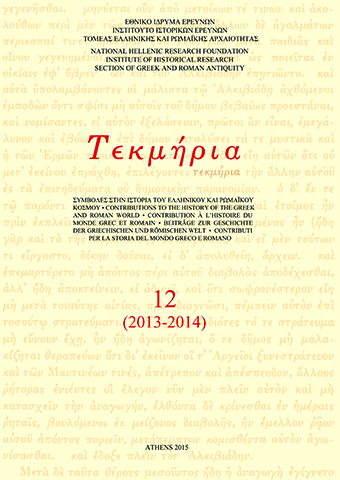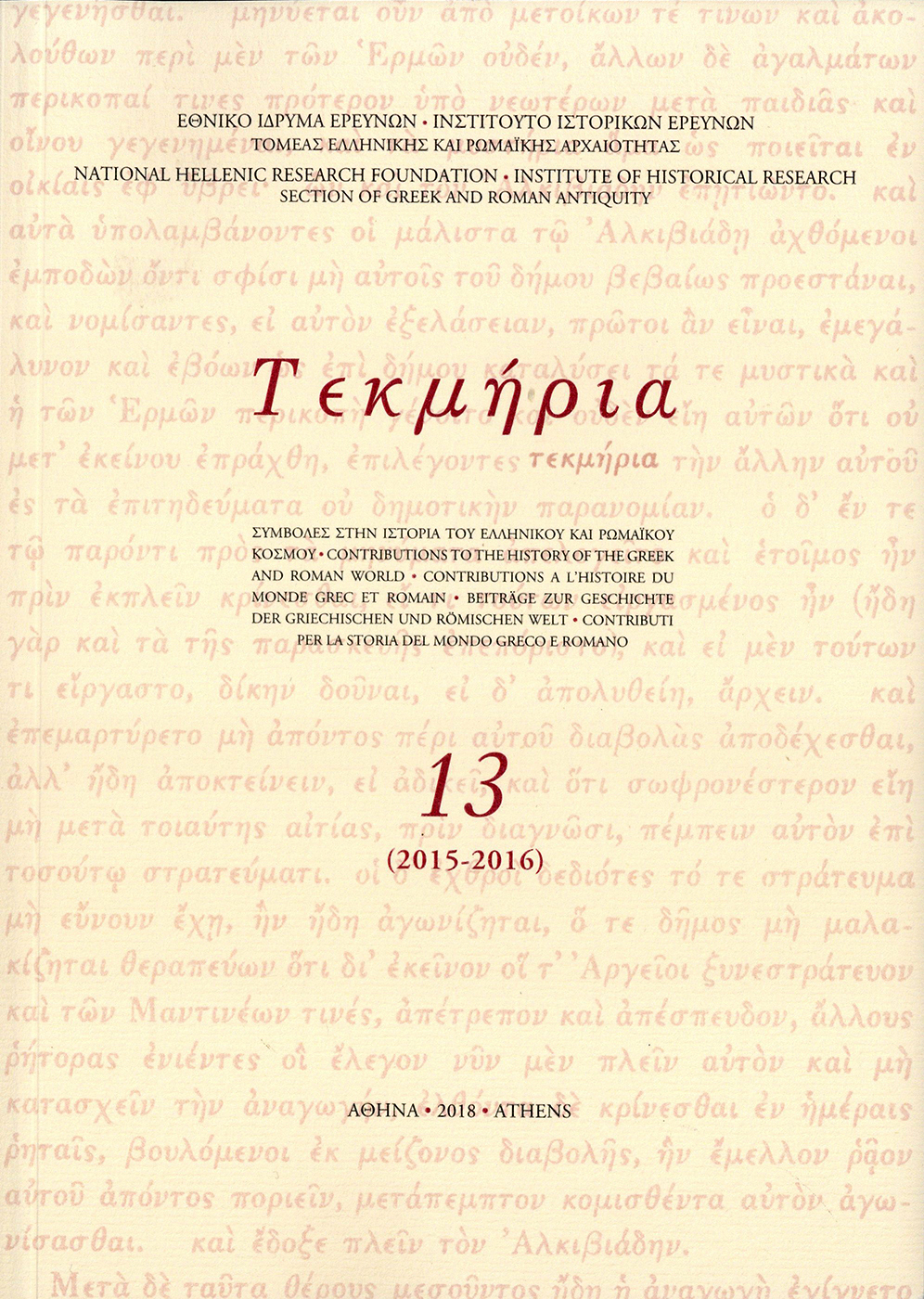Isiac Cults, Civic Priesthood and Social Elite in Hellenistic Demetrias (Thessaly): Notes on RICIS 112/0703 and beyond
Περίληψη
Λεπτομέρειες άρθρου
- Πώς να δημιουργήσετε Αναφορές
-
Kravaritou, S. (2016). Isiac Cults, Civic Priesthood and Social Elite in Hellenistic Demetrias (Thessaly): Notes on RICIS 112/0703 and beyond. Τεκμήρια, 12, 203–233. https://doi.org/10.12681/tekmeria.305
- Τεύχος
- Τόμ. 12: (2013-2014)
- Ενότητα
- Άρθρα

Αυτή η εργασία είναι αδειοδοτημένη υπό το CC Αναφορά Δημιουργού – Μη Εμπορική Χρήση – Παρόμοια Διανομή 4.0.
Οι συγγραφείς των άρθρων που δημοσιεύονται στα Τεκμήρια διατηρούν τα δικαιώματα πνευματικής ιδιοκτησίας επί των άρθρων τους, παραχωρώντας στο περιοδικό το δικαίωμα της πρώτης δημοσίευσης. Άρθρα που δημοσιεύονται στα Τεκμήρια μπορούν να χρησιμοποιούνται ελεύθερα για μη κερδοσκοπικούς σκοπούς, χωρίς δικαίωμα τροποποίησης (δημιουργία παράγωγου έργου), με αναφορά στο συγγραφέα και στην πρώτη δημοσίευση. Το Εθνικό Ίδρυμα Ερευνών διατηρεί το δικαίωμα να δημοσιεύει, να αναπαράγει, να παρουσιάζει στο κοινό, να διανέμει και να χρησιμοποιεί άρθρα που δημοσιεύονται στα Τεκμήρια σε οποιοδήποτε μέσο και μορφή, είτε μεμονωμένα είτε ως μέρη συλλογικών έργων, για όλο το χρόνο διάρκειας προστασίας της πνευματικής ιδιοκτησίας και για όλες τις χώρες του κόσμου. Αυτό περιλαμβάνει, ενδεικτικά και όχι αποκλειστικά, το δικαίωμα δημοσίευσης των άρθρων σε τεύχη του περιοδικού Τεκμήρια, αναπαραγωγής και διανομής μεμονωμένων αντιγράφων των άρθρων, αναπαραγωγής ολόκληρων των άρθρων σε άλλη έκδοση του ΕΙΕ, και αναπαραγωγής και διανομής των άρθρων ή της περίληψης τους με χρήση πληροφορικού συστήματος αποθετηρίου.
Λήψεις
Αναφορές
J. Aliquot, “Aegyptiaca et Isaica de la Phénicie et du Liban aux époques hellénistique et romaine”, Syria 81 (2004) 201-228.
I. Arnaoutoglou, “Group and Individuals in IRhamnous 59 (SEG 49.161)”, in J.-Chr. Couvenhes and S. Milanezi (eds), Individus, groupes et politique à Athènes de Solon à Mithridate. Actes du Colloque International, tours 7 et 8 mars 2005 (Presses Universitaires François Rabelais, Tours 2007) 315-337.
I. Arnaoutoglou, “ ‘Ils étaient dans la ville, mais tout a fait en dehors de la cité’. Status and identity in private Religious associations in Hellenistic Athens”, in O. M. van Nijf, R. Alston and C.G. Williamson (eds), Political Culture in the Greek City after the Classical Age (Leuven-Paris-Walpole 2011) 27-48.
I. Arnaoutoglou, “Cultural Transfer and Law in Hellenistic Lycia: The Case of Symmasis Foundation”, in Transferts culturels et droits dans le monde grec et hellénistique (Paris: Publications de la Sorbonne, 2012) 205–224
I. Arnaoutoglou, “Koinon Isiastan Sarapiastan. Isiac Cult Associations in the Eastern Mediterranean” (in preparation).
A. Arvanitopoulos, Θεσσαλικά Μνημεία (Athens 1909). A. Arvanitopoulos, “Ανασκαφαί και έρευναι εν Θεσσαλία”, PAE (1915) 130-200.
A. Arvanitopoulos, “Ανδριάντες Γαΐου Καιλίου ‘Ρούφου και Γαΐου Ιουλίου Καίσαρος εν Δημητριάδι”, Πολέμων Α ́ (1929) 201–206.
M.-F. Baslez, “Une association isiaque: les Melanephores” CdE 50 (1975) 297-303.
M.-F. Baslez, “Les associations à Délos: depuis les débuts de l’indépendance (fin du IVe siècle) à la période de la colonie athénienne (milieu du IIe siècle)”, in P. Fröhlich and P. Hamon (eds), Groupes et associations dans les cités grecques (IIIe siècle av. J.-C. – IIe siècle apr. J.-C.). Actes de la table ronde de Paris, INHA, 19-20 juin 2009, (Hautes études du monde gréco-romain 49, Paris 2013) 227-250.
A. Batziou-Efstathiou, Demetrias (TAPA, Athens 2002) 13.
A. Batziou-Efstathiou and Y. Pikoulas, “A Senatus Consultum from Demetrias”, in Y. Pikoulas (ed.), Inscriptions and History of Thessaly. New Evidence. Proceedings of the International Symposium in honour of Professor Christian Habicht (Volos 2006) 79-89.
A. Batziou and Y. Pikoulas, “Ψήφισμα του κοινού των Μαγνήτων” (under publication). C. Bonnet , Astarté. Dossier documentaire et perspectives historiques (Rome 1996).
26.
C. Bonnet, “Le roi et la déesse. À propos de la dédicase grecque à Ptolemée et Aphrodite de la grotte de Wasta, près de Tyr”, SEL 21 (2004) 125-140.
L. Bricault, Atlas de la diffusion des cultes isiaques (IVe s. av. J.-C. –IVe s. ap. J.-C.), (Mémoires de l’Académie des Inscriptions et Belles Lettres 23, Paris 2001).
L. Bricault, “La diffusion isiaque: Une esquisse”, in P.C. Bol, P.C. Kaminski and C. Maderna (eds), Fremdheit-Eigenheit. Ägypten, Griechenland und Rome. Austausch und Verständnis (Städel-Jahrbuch 19, Munich 2004) 548-556.
L. Bricault, Recueil des inscriptions concernant les cultes isiaques (Mémoires de l’ Academie des Inscriptions et Belles Lettres 31, Paris 2005).
L. Bricault, “Associations isiaques d’Occident” in A. Mastrocinque and C. Giuffre Scibona (eds), Demeter, Isis, Vesta and Cybele. Studies in Greek and Roman religion in honour of G. Sfameni Gasparo (Stuttgart 2012) 91-104.
L. Bricault, Les cultes isiaques dans le monde Greco-romaine. Textes réunis, traduits et commentés (Les Belles Lettres, Paris 2013).
Ph. Bruneau, “ Isis Pélagia à Délos”, BCH 85 (1961) 435-446. Ph. Bruneau, “Isis Pélagia à Délos (Compléments)”, BCH 87 (1962) 301-308.
P. Bruneau, Recherches sur les cultes de Délos à l’époque hellénistique et à l’époque impériale (Paris 1970).
P. Bruneau, Le sanctuaire et le culte des divinités égyptiennes à Éretrie (Leiden 1975). A. Chaniotis, ‘Greek Ritual Purity. From Automatisms to Moral Distinctions’, in P. Rösch
and U. Simon (eds), How Purity in Made (Harrassowitz Verlag, Wiesbaden 2012) 123-139.
A. Chaniotis, “Public Subscriptions and Loans as Social Capital in the hEllenistic City : Reciprocity, Performance, Commemoration”, in P. Martzavou and N. Papazarkadas (eds), The Epigraphy of the Post-classical polis. Fourth Century BC to Second Century AD. Papers from the Oxford Epigraphy Workshop (Oxford University Press, Oxford 2013) 89-106.
A. Chaniotis, “Illusions of Democracy in the Hellenistic World”, in Athens Dialogues E- Journal(http://athensdialogues.chs.harvard.edu/cgibin/W ebObjects/athensdialogues.woa/wa/d ist?dis=43). Last accessed at 24/04/2014.
J.-Cl. Decourt and A. Tziafalias, “Cultes et divinités isiaques et Thessalie: Identité et urbanization”, in L. Bricault, M.J. Versluys, P.G.P. Meyboom (eds), Nile into Tiber. Egypt in the Roman World. Proceedings of the IIIrd International Conference of Isis Studies, Faculty of Archaeology, Leiden University, Mai 11-14 2005 (Leiden-Boston 2007) 329-363.
B. Dignas and K. Trampedach (eds), Practitioners of the Divine, Greek Priests and Religious Officials from Homer to Heliodorus (Washington 2008) 73-88.
F. Dunand, Le culte d’Isis dans le basin oriental de la Méditerranée III. Le culte d’Isis en Asie Mineure. Clergé et rituel des sanctuaires isiaques (Leiden 1973).
P. M. Frazer, “Two Studies in the Cult of Sarapis in the Hellenistic World”, OAth 3 (1960) 1- 54.
P.M. Frazer, Ptolemaic Alexandria I (Oxford 1972). Chr. Habicht, Studien zur Geschichte Athens in hellenistischer Zeit (Göttingen 1982).
M. B. Hatzopoulos, Macedonian Institutions under the Kings II (Athens 1996).
K. Harter-Uibopuu, “Money for the polis. Public Administration of Private Donations in Hellenistic Greece”, in O. M. van Nijf and R. Alston (eds), Political Culture in the Greek city after the Classcial Age (Peters, Leuven-Paris-Walpole 2011) 119-139.
Br. Helly, “La Thessalie à l’époque romaine”, in J. Cazeau and al. (eds), Mémoires du Centre Jean Palerne II (Université de Saint-Étienne 1980) 37–50.
Br. Helly, “Les Italiens en Thessalien au IIe et au Ier s. av. J.-C”, in Les bourgeoisies municipales italiennes au IIe et 1er siècles av. J.-C : Centre Jean Bérard, Institut français de Naples, 7-10 décembre 1981 (Editions du Centre National de la Recherche Scientifique, Paris and Centre Jean Bérard, Naples 1983) 355–380.
M. Horster and A. Klöckner (eds), Civic Priests. Cult Personnel in Athens from the Hellenistic Period to Late Antiquity (Walter de Gruyter, Berlin-Boston 2012).
M. Horster and A. Klöckner (eds) Cities and Priests. Cult Personnel in Asia Minor and the Aegean Islands from the Hellenistic to the Imperial Period (Walter de Gruyter, Berlin-Boston 2013).
B. Intzesiloglou, “Ο συνοικισμός και η πολιτική οργάνωση της Δημητριάδας και του Κοινού των Μαγνήτων κατά την Ελληνιστική περίοδο” in E. Kontaxi (ed.), Αρχαία Δημητριάδα. Η διαδρομή της στο χρόνο. Πρακτικά ημερίδας 9 Νοεμβρίου 1994 (Δημοτικό Κέντρο Ιστορίας και Τεκμηρίωσης, Βόλος 1996) 91-109.
M. Kantirea, Les dieux et les dieux augustes. Le culte imperial en Grèce sous les Julio- claudiens et les Flaviens. Études épigraphiques et archéologiques (Meletemata 50. Athens 2007).
28
S. Kravaritou, “Synoecism and religious interface in Demetrias (Thessaly)”, Kernos 24 (2011) 111-135.
S. Kravaritou, “Thessalian Perceptions of the Ruler Cult: ‘archegetai and ktistai’ from Demetrias” in P. Martzavou and N. Papazarkadas (eds), The Epigraphy of the Post-classical polis. Fourth Century BC to Second Century AD. Papers from the Oxford Epigraphy Workshop (Oxford University Press, Oxford 2013) 255-275.
J. Ma, Statues and Cities. Honorific Portraits and Civic Identity (Oxford University Press, Oxford 2013).
M. Malaise, “Les hypostoles. Une titre isiaque, sa signification et sa traduction iconographique”, CdE 82 (2007) 302-322.
P. Martzavou, “Les cultes isiaques et les Italiens entre Delos, Thessalonique et l’Eubée”, Pallas 84 (2010) 181-205.
P. Marzolff, “Η πολεοδομική εξέλιξη και τα κυριότερα αρχιτεκτονικά έργα της περιοχής της Δημητριάδας”, in E. Kontaxi (ed.), Αρχαία Δημητριάδα. Η διαδρομή της στο χρόνο. Πρακτικά ημερίδας 9 Νοεμβρίου 1994 (Volos 1996) 91–109
O. Masson, “Recherches sur les Phéniciens dans le monde hellénistique”, BCH 93.2 (1969) 679-700.
L. Migeotte, Les souscriptions publiques dans les cités grecques (Quebec 1992). J. Mylonopoulos, “The Dynamics of Ritual Space in the Hellenistic and Roman east’, Kernos
21 (2008) 49-79. F. Poland, Geschichte des griechischen Vereinswesens (Leipzig 1909).
G. Reger, “Hellenistic Greece and Western Asia Minor”, in W. Scheidel, I. Morris, R. Saller (eds), The Cambridge Economic History of the Greco-Roman World (Cambridge 2008) 460- 486.
E. Rogers, The Copper Coinage of Thessaly (London 1932).
A. Schachter, “Egyptian Cults and Local Elites in Boiotia”, L. Bricault, M.J. Versluys, P.G.P. Meyboom (eds), Nile into Tiber. Egypt in the Roman World. Proceedings of the IIIrd International Conference of Isis Studies, Faculty of Archaeology, Leiden University, Mai 11- 14 2005 (Leiden-Boston 2007) 364-389.
E. Skafida, “Το Κάστρο-Παλαιά Βόλου κατά τους Ρωμαϊκούς χρόνους”, in A. Mazarakis- Ainian (ed.), Proceedings of the third Archaeological Work in Thesally and Central Greece, Volos 12.3–15.3-2009, Volos 2012, 149–158.
S. Kravaritou and E. Skafida, ‘New Inscriptions from Kastro-Palaia Volos”, (in preparation).
M. Stamatopoulou, “Ouaphres Horou, an Egyptian Priest of Isis from Demetrias”, in D. Kurtz and al. (eds.), Essays in Classical Archaeology for Eleni Chatzivassiliou 1977-2007 (Oxford 2008) 249-257.
L. Vidman, Isis und Sarapis bei den Griechen un Römern: Epigraphische Studien zur Verbreitung und zu den Tragern des ägyptischen Kulten (Religionsgeschichtliche Versuche und Vorarbeiten 29, Berlin 1970).
E. Voutiras, “Sancturaire privé-culte publique?”, in V. Dasen and M. Piérard (eds), Idia kai dèmosia. Les cadres “privés” et “publics”’ de la religion grecque antique. Actes du IXe Colloque du CIERGA, Fribourg 8-10, septembre 2003 (Kernos Suppl. 15, Liège 2005) 273- 288.
A. Wilchelm, “Inschriften aus Thessalien”, MDAI (1890) 284-316.




